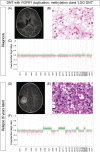The genomic landscape of dysembryoplastic neuroepithelial tumours and a comprehensive analysis of recurrent cases
- PMID: 35836307
- PMCID: PMC9542977
- DOI: 10.1111/nan.12834
The genomic landscape of dysembryoplastic neuroepithelial tumours and a comprehensive analysis of recurrent cases
Abstract
Aims: Dysembryoplastic neuroepithelial tumour (DNT) is a glioneuronal tumour that is challenging to diagnose, with a wide spectrum of histological features. Three histopathological patterns have been described: specific DNTs (both the simple form and the complex form) comprising the specific glioneuronal element, and also the non-specific/diffuse form which lacks it, and has unclear phenotype-genotype correlations with numerous differential diagnoses.
Methods: We used targeted methods (immunohistochemistry, fluorescence in situ hybridisation and targeted sequencing) and large-scale genomic methodologies including DNA methylation profiling to perform an integrative analysis to better characterise a large retrospective cohort of 82 DNTs, enriched for tumours that showed progression on imaging.
Results: We confirmed that specific DNTs are characterised by a single driver event with a high frequency of FGFR1 variants. However, a subset of DNA methylation-confirmed DNTs harbour alternative genomic alterations to FGFR1 duplication/mutation. We also demonstrated that a subset of DNTs sharing the same FGFR1 alterations can show in situ progression. In contrast to the specific forms, "non-specific/diffuse DNTs" corresponded to a heterogeneous molecular group encompassing diverse, newly-described, molecularly distinct entities.
Conclusions: Specific DNT is a homogeneous group of tumours sharing characteristics of paediatric low-grade gliomas: a quiet genome with a recurrent genomic alteration in the RAS-MAPK signalling pathway, a distinct DNA methylation profile and a good prognosis but showing progression in some cases. The "non-specific/diffuse DNTs" subgroup encompasses various recently described histomolecular entities, such as PLNTY and diffuse astrocytoma, MYB or MYBL1 altered.
Keywords: DNA methylation profiling; FGFR1; dysembryoplastic neuroepithelial tumours; glioneuronal tumours; molecular pathology; paediatric low-grade gliomas.
© 2022 The Authors. Neuropathology and Applied Neurobiology published by John Wiley & Sons Ltd on behalf of British Neuropathological Society.
Conflict of interest statement
The authors declare no conflict of interest.
Figures





References
-
- Blumcke I, Spreafico R, Haaker G, et al. Histopathological findings in brain tissue obtained during epilepsy surgery. N Engl J Med. 2017;377:1648‐1656. - PubMed
-
- Sharma MC, Jain D, Gupta A, et al. Dysembryoplastic neuroepithelial tumor: a clinicopathological study of 32 cases. Neurosurg Rev. 2009;32:161‐169. discussion 169‐170. - PubMed
-
- Chassoux F, Landré E, Mellerio C, Laschet J, Devaux B, Daumas‐Duport C. Dysembryoplastic neuroepithelial tumors: epileptogenicity related to histologic subtypes. Clin Neurophysiol. 2013;124:1068‐1078. - PubMed
Publication types
MeSH terms
Grants and funding
LinkOut - more resources
Full Text Sources
Medical
Miscellaneous

